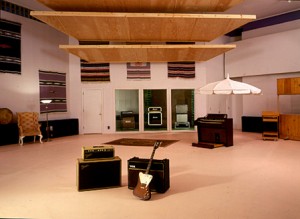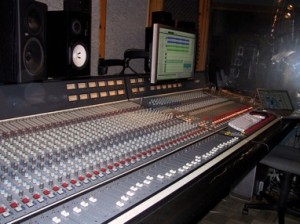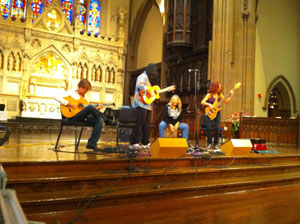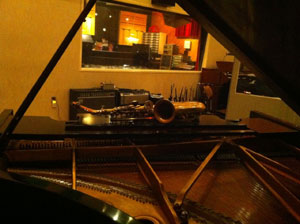Rich Lamb — Nomad Engineer: The Favorite Studios of an NY Freelancer (Part I)
TRIBECA/CHINATOWN, MANHATTAN: Rich Lamb is a studio nomad. He’s an NYC audio hired gun who works in studios and recording situations that span the region – turns out, Lamb has a lot of favorite local places to work, and he’s going to share them with us right here.
Based in TriBeCa/Chinatown, Lamb (pitchie@earthlink.net) is a professional audio engineer – period. His freelance recording and mixing practice can take him clear across NY state or to the next door down, and the flexibility has paid off: Today Lamb’s discography includes The Brecker Brothers, They Might Be Giants, John Cale, Antony and the Johnsons, The Asylum Street Spankers, Debbie Deane, Ian Hunter, Willie Nile, Cherish the Ladies, and Joan Osborne. Allmusic.com has more.
Lamb was 18, living at home on Long Island and driving to college one day, when he saw a life-changing sign for an audio school. “Eventually I dropped out of college and pursued a 30-week program with complete dedication,” he recalls. “After some time out of college, which included interning at a local studio in a basement with quite a bit of impressive gear — Ampex 2, API board, etc… I got a degree at Berklee College of Music, taking their Music Production and Engineering major.”
Shiny new diploma in hand, Lamb started by assisting at Skyline Studios, followed by the Power Station [now Avatar] before forging out on his own. He scored his first semi-steady gig doing house audio for Blue Man Group, and “My career has been a combination of studio, live, and corporate audio ever since.”
When we met at the Massey Plugins mixer at Lakeside Lounge, I enjoyed hearing your philosophy on how you work as an engineer. What do you find so fulfilling about a freelance career where you’re on call to go anyplace and record or mix?
Not that it was intentional, but I guess the most stimulating thing about freelancing in audio is that there’s rarely a dull moment if you’re always in different rooms. You have to remember different layouts, different patch bays, what mics are available, what drawbacks and strengths there are to each room, and how to adjust your ears to different monitoring situations — from control rooms to large venues, different PAs, indoor or outdoor. Either way, you have to mix differently when you have an outdoor gig and you’re used to the studio, and vice versa.
For example, you begin to understand EQ as something to enhance or sculpt — like in the studio — versus it being used more for damage control or feedback attenuation, when working live. Same with compression. Being able to juggle different types of gigs really enhances your troubleshooting reflexes too, though someone who works just one room could argue that he’s fast because his knows his room cold.
But my approach to my career is about doing whatever it takes to advance myself through great projects that I get to record and mix. Ideally each great album gets me recommended to someone new, or hired back. If it pays the bills and I enjoy it, I’m not too worried about whether it’s going to “go anywhere.” I don’t work on spec. Even if it’s a close friend, which can be a blast, I have to charge something fair, otherwise I’ll put off working on their stuff.
When it comes to projects that are dear to me, including projects where I have a say on where we track or what musicians we should use, even if I’m not technically producing, my first choice is to do a large chunk of work in any of the studios where I work at the most. If they can’t afford the expensive one, we go to a more affordable place, work within our limitations, forego the real piano and the awesome acoustics, and get the job done well either way. I’m drawn to producers and studios that generally make music I’m into. How else can you improve at your craft than get to practice on the styles you like? The more work feels like play the more aligned you are with your purpose, and you’ll probably live a longer and healthier life.
By the way, in fairness to top-dollar studios and musicians, they aren’t always more expensive in the end. Professionals get the job done faster AND the results are better, saving you time in editing or even recutting tracks later, and you’re happier with your tracks.
Why did you like the idea of telling us about all the different places you work in, in and around NYC?
Because this information should be shared. I want to know more NYC rooms, while alerting my peers to the places I work at. Everyone wins when more artists and producers are hip to several studios, and comfortable at all these places.
Therefore, in no particular order, here we go. In fact I’m starting with the one I hardly work at nowadays:
Water Music Recorders, 931 Madison St., Hoboken NJ 07030, 201-420-7848
This is probably where I did my first freelance sessions. Owner Rob Grenoble, a gregarious storyteller with a HUGE knowledge of the biz, respected me just because I was a Skyline alumnus.
Huge live room with concrete floors, for more of a sustained reverb, particularly nice for horns or strings, plus a big Neve/Studer control room, where the Augspurgers sound like the NS10s, only bigger, making for a smooth transition. The North Room is interesting in that it’s affordable though a little funky, yet you get a lot of the same acoustics.
Working at Water Music, I feel like I’m closer to Woodstock for some reason. Maybe because it’s a residential studio! I’d love to be someone like John Agnello and just put in long days with the band and then crash in the duplex, having no commute the next day. Tons of indie rock albums are done at Water Music, they have a very impressive client list. And I’m impressed with any studio that lasts in this day and age. Go there if you want a great near-NYC rock studio with residency.
Mark Dann Recording, 59 Franklin St., NYC 10013 212-941-7771
Mark Dann is an accomplished musician, especially on bass, and he has had a facility in a TriBeCa loft for 20 years. I started bringing work there in 1994. He is the man to go to if you have any technical questions, especially regarding Apple or Pro Tools, and if you have drum tracks that need replacing or vocals that need to be tuned.
His way of working is extremely organized, he’s a great editor, and he mixes and masters with a keen ear and perpetual student’s inquisitiveness. His enthusiasm for the craft of recording and technology is such that he’d rather talk about plug-ins than anything! But lots of us get that way!
In Woodstock he runs an identical PT system — allowing projects to work between the two rooms – in a nice tracking space with a piano and B-3. Where a lot of studios always fall by the wayside, here and in the Woodstock area, Mark has hung in there and even thrived. Hiring Mark to do your album is quite a bang for the buck. More people should know about both of his rooms. His Mac is decked out with every plug-in you could ever want. There are also some nice preamps and a great DDA console. Check out his site, too.
Before I continue I want to mention two other colleagues I’ve worked with or for: A.T. Michael MacDonald and Tom Durack, both fellow alumni from Skyline. Michael MacDonald has done a lot of stunning jazz albums — Fred Hersch, McCoy Tyner, Roy Haynes — and is a superb mastering engineer, running his own studio in DUMBO, called AlgoRhythms which has a fantastic combination of analog and digital gear, plus Dunlavy monitors. I like bringing my work to a place where I can hear much more detail than I can at home — that’s the whole point! Michael has taught me so much about mastering — I used to work for him — and audio in general…he’s my mentor more than anyone else. The ultimate piano recording for my money would be Michael engineering at Ambient Recording in Stamford, CT.
Tom Durack has been an inspiration ever since I met him at Skyline, which he had ‘graduated’ from, to working there as Nile Rodgers’ engineer. Sitting in on the razor blade editing of the single release of “Love Shack” was a trip. I have always been struck by Tom’s abilities to track and mix albums that sound as good as you could imagine. He’s been great to run mixes by, plus he is now a co-worker of mine at Trinity, and one of my closest friends. He too has impeccably mastered a few of the albums I’ve mixed.
Next up, Trinity Church Wall Street/St. Paul’s Chapel, Broadway at Wall Street, NYC
An old friend who was working at Trinity recommended me for this gig, which has gone from doing house sound for services and concerts, to now streaming for the church’s large Web audience, plus field audio, Pro Tools editing, outdoor concerts and live conferences that transmit to sister Episcopal churches around the world. It’s the gig that keeps giving, and it’s quite educational.
And Trinity Church is never going to go away. How many studios stick around for over 200 years? The church itself provides the constant challenge of knowing how to function while basically working inside an echo chamber.
Systems Two Recording Studios, 117 Ditmas Ave., Brooklyn NY 10018, 718-851-1010
Of all the places where I have put in a lot of hours as a freelancer (post-Skyline and Power Station), Systems Two is easily the most glamorous, and the place I’ve gotten the most work from since 2002. Over 30 years in business, making thousands of clients happy, mostly in jazz, it’s basically a mom-and-pop business with none of the huge overhead of payroll that weighed down the Manhattan places I remember.
Between the two of them, husband and wife owners Joseph and Nancy Marciano wear the various hats of chief engineer, assistant, manager, bookkeeper, and general maintenance! The other main engineer is Michael Marciano, brother of Joseph. There’s an assistant engineer who now engineers a lot, and myself, I’m brought in around twice a week for much of the rest, lots of evenings and weekends. I’ve had this gig for nine years, it’s my one long commute, but that’s what books and iPods are for.
Their famous Steinway is from Carnegie Hall, their C3 and drum kit are also legendary, one of their ribbon mics is John Coltrane’s, etc. Nice big room with a short reverb which works for just about everything. Their main bread and butter comes from being a top-notch, word-of-mouth jazz studio, even though they sometimes do everything else, including orchestral, choral, metal, etc. Their discography is staggering. They have two Pro Tools rooms and one mastering room.
Way out there, but only yards from the F train. I love these people and I love this place — I open up a mic and it always sounds good. When I come in it always looks like I’m doing the first session of the day, even if a big band just finished up an hour ago. Work there is effortless: no wrestling with acoustics, monitoring, or a finicky patch bay. It’s my first choice for any client that can afford to work there.
Next week, come back for Part II of Rich Lamb — Nomad Engineer: Going to the Fab Faux, Maxing Cable Access, and Hitting the Poconos. Write Rich at pitchie@earthlink.net to join his Song of the Week email list!!!
Please note: When you buy products through links on this page, we may earn an affiliate commission.












Noreen Romano
November 6, 2010 at 7:08 pm (13 years ago)Rich Lamb ROCKS!
George Joseph
July 1, 2014 at 8:42 pm (10 years ago)Agree with Noreen…Rich Lamb is amazing! Easy to work with, extremely knowledgeable, and made our recording a blast. Thanks for a great session!